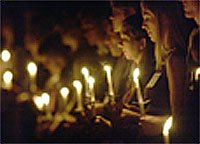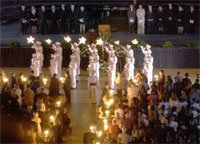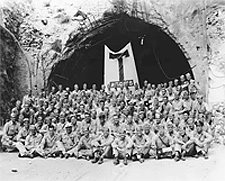
Nothing speaks more clearly of the Aggie Spirit and Aggie family than Muster. A dictionary definition of “muster” refers to “a gathering of soldiers for a particular reason” and “to summon up something such as strength or courage.” Aggie Muster is all that and much more. It is uniquely American, uniquely Texan and most certainly uniquely Aggie – a most fitting tradition for a uniquely American institution.
Held each April 21 in approximately 320 locations around the world, Muster is one of Texas A&M’s most solemn and visible traditions. In each of those locations, it is a time set aside to honor the memory of Aggies from that area who have died since the last Muster ceremony. No matter where Aggies are, whether they are as few as two or as many as the thousands who gather in Reed Arena on the Texas A&M campus, they come together each April for Muster.
Muster has its roots in Texas A&M’s military tradition. Muster was first held on June 26, 1883 when the then Agricultural and Mechanical College of Texas was less than a decade old and all students were male and members of the Corps of Cadets. Former students – then called ex-cadets – were called to gather so they might “…live over again our college days, the victories and defeats won and lost upon drill ground and classroom. Let every alumnus answer a roll call.”
By 1903, the “ex-cadets” felt not enough was being done to celebrate Texas' independence – specifically on San Jacinto Day (April 21) when that independence won in battle was annually commemorated. It was not until 1922, however, that April 21 became the official day of Muster and by 1923, the March edition of the “Texas Aggie” alumni magazine gave the following directive: “If there is an A&M man in one-hundred miles of you, you are expected to get together, eat a little, and live over the days you spent at the A&M College of Texas.” Today, when Aggies gather for Muster, barbecues are often part of the event. Also, the Aggie class celebrating the 50th anniversary of its graduation now comes to campus for a reunion in conjunction with Muster.
"No occasion can be more sacred than one where we honor those who have honored us... The other significance of the Aggie Muster is to remind us of our duty as Aggies to the past, present, and future. We are the beneficiaries of the tireless and unselfish sacrifices of those we honor today, but we are also the recipients of responsibilities which, to faithfully discharge, will require the best that you and I possess." James W. Aston '33
Part of “living over those college days” is remembering those who are no longer around to share those memories. Every Aggie contributes to and becomes a part of the Aggie Spirit and that is something that even death cannot change. That spirit is honored and remembered at Muster.
"For no matter how many years may pass, what physical changes come, no matter how the generations rise and fall away, A&M - that is to say the essential spirit of A&M - will never pass away." - James K. Pipkin. Class of 1929.
On campus on the evening of Muster, the Aggie family gathers in Reed Arena for ceremonies that include the “Roll Call for the Absent” for those Aggies whose memories will be honored there. In the dark and hushed assembly, the names of those who have died in the past year are read, and as each name is called, a family member or friend will answer “Here” and a candle will be lit. A “Roll Call for the Absent” will also be read at each of the off-campus Muster ceremonies to honor the memory of Aggies from the locales represented or for other classmates/friends as requested.
 At the campus Muster, there is then the sound of a slow, steady cadence ... a glimpse of white ... and members of the Corps of Cadets Ross Volunteer Company march out of the darkness. In quiet unison rifles are raised and fired three times ... shattering the silence. Echoing in the darkness is the special arrangement of taps.
At the campus Muster, there is then the sound of a slow, steady cadence ... a glimpse of white ... and members of the Corps of Cadets Ross Volunteer Company march out of the darkness. In quiet unison rifles are raised and fired three times ... shattering the silence. Echoing in the darkness is the special arrangement of taps. ...."all is well ...safely rest ....God is nigh."
 Muster was held in Europe during World War I, where many groups of Aggies were among the American soldiers serving their country in trenches far from home but still a part of the Aggie family. That scenario played out on an even greater scale in World War II, with the most famous Muster held when Gen. George F. Moore, Texas A&M Class of 1908, was the commander of Fort Mills on Corregidor Island in the Philippines. He, along with 25 other Aggies on the island, held a Muster celebration on April 21, 1942, just days before the island fell and all those Aggies were either killed or captured. According to Jerry Cooper, Class of 1963, who is updating a book on Muster speeches, Thomas Dooley, Col. USA (Ret.) who died March 26, 2006 in Hopkinsville, Kentucky at the age of 92, was responsible for the Aggie Muster story being sent from Corregidor before its capture by the Japanese. Dooley’s message resounded in the halls of Congress and was reported across the nation. After the war, in 1946, Aggies who were present among the American armed forces on Corregidor once again held Muster on the island.
Muster was held in Europe during World War I, where many groups of Aggies were among the American soldiers serving their country in trenches far from home but still a part of the Aggie family. That scenario played out on an even greater scale in World War II, with the most famous Muster held when Gen. George F. Moore, Texas A&M Class of 1908, was the commander of Fort Mills on Corregidor Island in the Philippines. He, along with 25 other Aggies on the island, held a Muster celebration on April 21, 1942, just days before the island fell and all those Aggies were either killed or captured. According to Jerry Cooper, Class of 1963, who is updating a book on Muster speeches, Thomas Dooley, Col. USA (Ret.) who died March 26, 2006 in Hopkinsville, Kentucky at the age of 92, was responsible for the Aggie Muster story being sent from Corregidor before its capture by the Japanese. Dooley’s message resounded in the halls of Congress and was reported across the nation. After the war, in 1946, Aggies who were present among the American armed forces on Corregidor once again held Muster on the island.Muster, so much a part of the Aggie Spirit, is a time to reflect on the past, hold on to the present and, as the dictionary says, “summon up strength or courage” and pass it on to the generations to come.
"Let us hold our lives up to the light of those who walked before us, remembering the footprints they left behind and preserving the pathways they created." - Jack Fritts, Class of 1953.
*Adapted from article by Tura King
3 comments:
While I have temendous respect for colleges that have deep tradition and loyalty from alumni, this is one of the reasons why it feels pretty much impossible for someone like me (not native Texan or Aggie Alum) to become a fan.
There is such a deep tradition I could never "be on the inside." Perhaps I can just admire it from a far.
We have a saying -- from the inside looking out you can't explain it, from the outside looking it you can't understand it. I think you have likely heard Me and/or Nate say that a few times. Muster is really an incredible experience -- one of those things that, once you go, you never forget it.
I remember when I went to visit Amy while she was at A&M, she took me to see a video all about this (she had told me about it and I watned to know more). The video alone was a powerful and moving experience, I can't imagine how actually attending one must be.
I remember the one for the bonfire incident as well. That year had extra special meaning.
Post a Comment